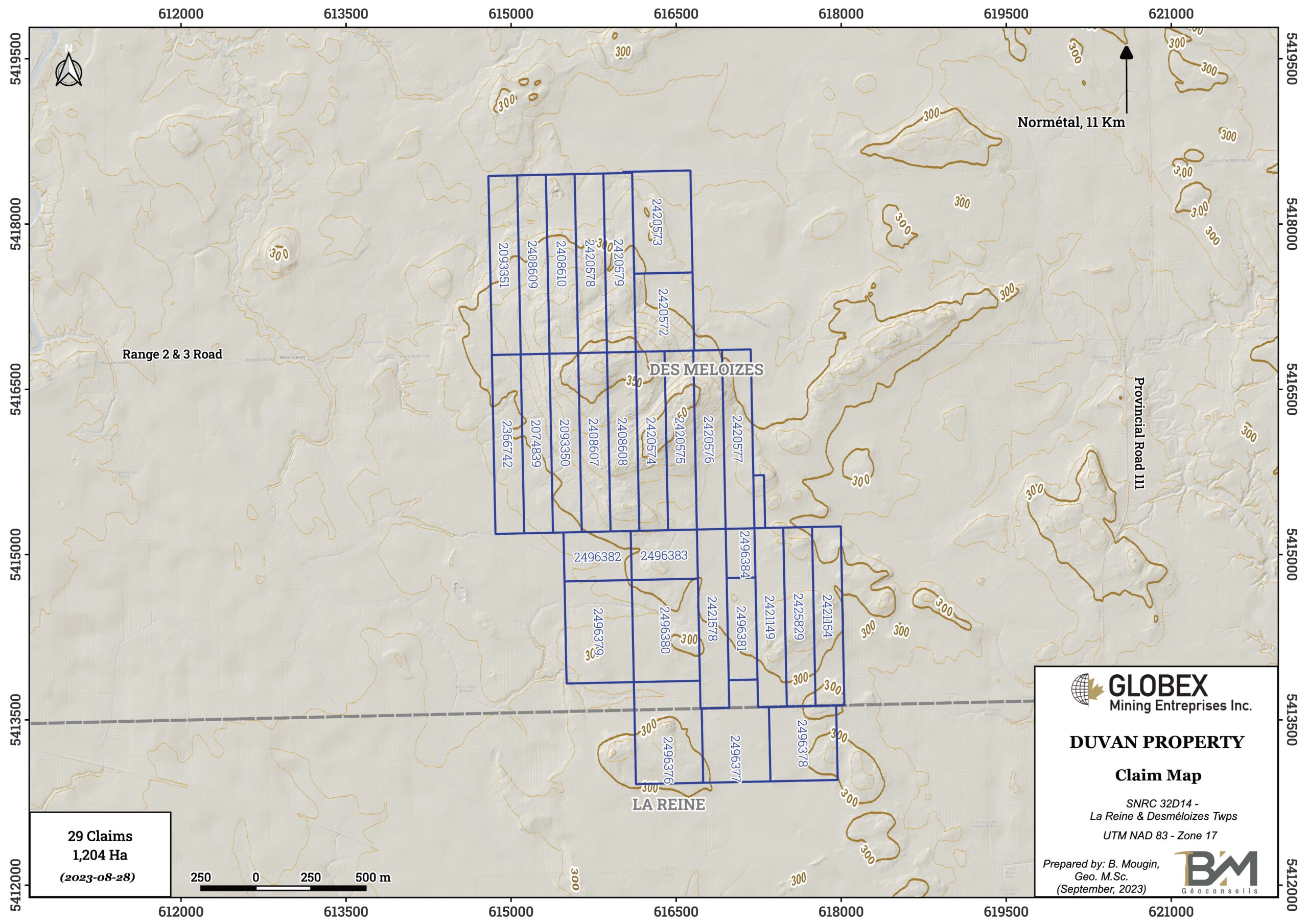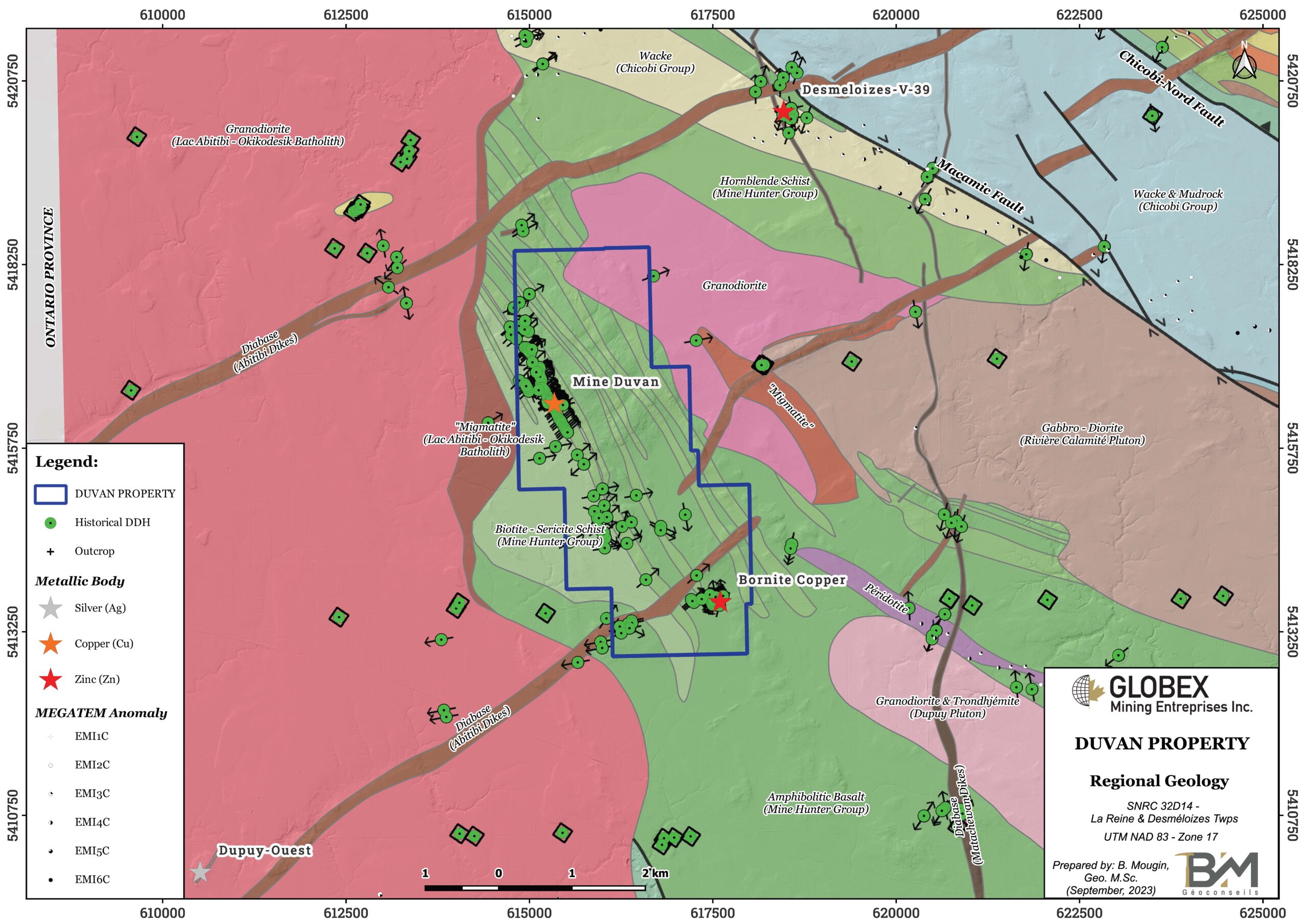Duvan Zone
Location, Access, Description
The Duvan property is located in Abitibi (Quebec Province) 15 km northwest of La Sarre and 75 km northwest from Rouyn-Noranda. It consists of 29 contiguous mining claims totaling 1,204 Ha in La Reine & Desméloizes townships (NTS 32D14). The claims are wholly owned by Globex and are not subject to any underlying royalties or third party interests.
Topography is quite rugged in the northern half of the property with elevations comprised between 290 m and 360 m above sea level. South half of the property is flatter and swampier due to the presence of several streams.
The property is accessible by car, driving on road 111 North from La Sarre, then turning on the Range 10 & 1 road or Range 2 & 3 road toward west. A network of trails and old lines then allows to move easily by walk or VTT within the property.
Geology and Mineralization
Regional Geology
The Duvan property is located in the Northern Volcanic Zone of the Abitibi Greenstone Belt of the Canadian Shield (Chown et al, 1992). Rocks of that area are represented by archean felsic to mafic volcanics and tuffs of Hunter Mine Group (HMG), intermediate to mafic volcanics and tuffs of Stoughton-Roquemaure Group (SRG) and sediments of the Chicobi Group. Numerous intrusions of tonalite, trondhjemite and granodiorite (TTG), diorite, gabbro, peridotite and diabase cut the archean sediments and volcanics. Dostal and Mueller (1996) indicate that rocks of the SRG conformably overlie those of the HMG, whereas Hocq (DV89-04) indicates a faulted contact between the HMG and SRG. The HMG is separated to the north from Amos Group volcanics and Chicobi Group sediments by the ESE Macamic fault. The Palmarolle, Poularies, Dupuy and Colombourg intrusions cut the Hunter Mine volcanics east of the Duvan property, while Lac Abitibi-Okikodesik Batholith intrude the HMG volcanics west of the property. Each of these intrusions are interpreted as being syntectonic (MB95-39).
The region was affected by two deformation events. In the area of the property, D1 formed folds with an E-W axial plane such as the Lake Abitibi Anticline and a main E-W schistosity while D2 formed large zones of ductile dextral strike-slip faults oriented generally NNW-SSE to WNW-ESE (GM55470). These faults as well as the syntectonic plutons have disrupted the orientation of the main schistosity. Magnetic data of Globex’s 2022 NOVATEM survey highlights a probable regional-scale fold whose axis would be SE-oriented.
Property Geology
The Duvan property lies directly east of the Lac Abitibi-Okikodesik Batholith. Rocks of the property are mainly composed of SE-oriented calk-alkaline amphibolitic basalts and biotite-sericite schists of the HMG. Due to high degrees of deformation, volcanics recorded a N140°/-75° penetrative schistosity. Granodiorite can be observed in the NE corner of the property. Proterozoic diabase dikes intersect all the rocks mentioned above in the southwest part of the property.
Metamorphism in rocks of the Duvan property reached the amphibolitic facies due to HT conditions caused by the setuping of Lac Abitibi-Okikodesik Batholith. Garnets can be observed in felsic tuffs along the Duvan horizon, and migmatites have even been described east and west of the property (MB95-39).
Mineralization
More than a dozen mineralized showings are listed west of La Sarre in the MRNQ bank, divided into three distinct mineralization types: 1) polymetallic sulphides associated with volcanics of the HMG and sediments of Chicobi ; 2) auriferous quartz veins related to intrusive rocks ; 3) nickel-bearing mineralization associated with ultramafic rocks.
Duvan property hosts both the former Duvan mine and Bornite Copper showing. A historical stripping by Noranda on the Duvan site exposes mineralization which consists of remobilized massive sulphides (bornite, chalcopyrite, silver, magnetite and pyrrhotite) in veins filling a shear zone within metavolcano-sedimentary rocks of the HMG. Best historical channel sampling assays on the DUV-92-02 stripping include 25% Cu, 1.34% Zn over 0.50 m (GM68961). Based on the lithological similarity of the host rocks, Lacroix (MB95-39) proposed that the mineralized horizon of the Duvan deposit represents a stratigraphic equivalent of the mineralized levels of the Hunter Mine. Diamond drilling (DDH) by Globex in 2015 also intersected gold mineralization in a weakly pyritized quartz vein within amphibolites (GM69420).
The Bornite Copper showing consists of a sulphide zone in intermediate volcanic rocks of the HMG. The mineralization consists of pyrite accompanied by sphalerite and chalcopyrite. Best historical DDH assays include 6.29% Zn, 0.51% Cu over 0.65 m (B-12) and 4.65% Zn, 0.49% Cu over 0.90 m (QDL 4).
History
The Duvan Copper prospect was discovered in 1925 by Rex Mining Ltd. Limited exploration was done between 1925 and 1952. Between 1952 and 1960, the Duvan Copper company carried out diamond drilling and dug a 304 m deep shaft and drilled galleries on 8 levels. This work resulted in a tonnage of 113,000t with an average grade of 2.5% Cu and 100 gpt Ag. In 1960, 1,160t of ore grading 12% Cu and 100.8 gpt Ag was processed at the Noranda smelter. Finally, the mine was closed in 1960 due to low copper prices.
Little exploration has been undertaken since the mine closure. One can mention Noranda Exploration’s work that undertook in 1992 geological mapping as well as magnetism (Mag) and induce polarization (IP) surveys, followed by 3 strippings and 2 DDH to test the extension of the Duvan horizon between 300 and 400 m of vertical depth (GM51666). Between 2011 and 2013, Globex carried out geophysic surveys followed by 527.65 m of DDH in 2015 in order to test an IP anomalie located 100 metres southeast of the Duvan mine (GM69420). Suplhide mineralization mainly composed of pyrite and pyrrhotite was intersected and hole DUV-15-01 returned 0.75 g/t Au over 1.00 m on a quartz vein.
Resources and Potential
The former Duvan mine produced 1,052 tonnes at 11.99% Cu and 100.80 g/t Ag in 1960. Non-43-101 resources are estimated at 101,000 tonnes grading 2.50% Cu (MB98-06).
Interpretation of a regional fold on the Duvan property on the NOVATEM survey reinforces the interest to explore the Duvan Mine horizon on the other fold flank and above all in the fold hinge, using the usual methods used for volcanogenic sulphides mineralisation, starting with core logging compilation, detailed EM and IP surveys, and rocks lithogeochemistry.



